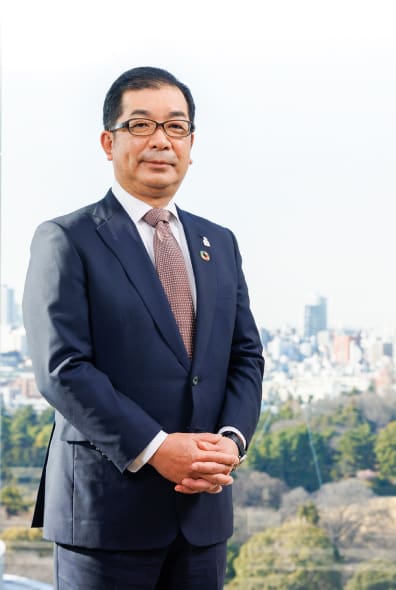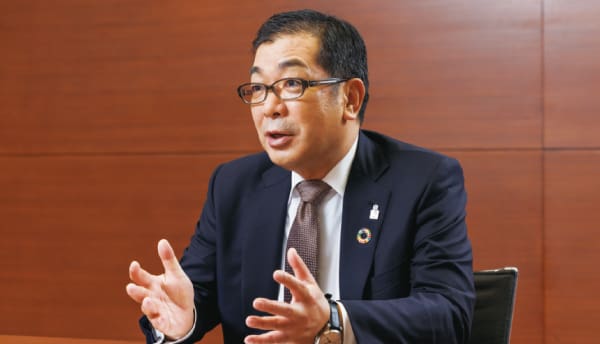[ Japanese ]
Management's Message


Our Global Vision
Creating happiness for residents to realize enriching lifestyles over increasingly long lifespans
Since its founding in 1960, Sekisui House has constantly been ahead of the curve, solving issues with advanced technologies while accumulating unmatched product strengths.
Looking at our history in 30-year segments, during the first phase, up to 1990, our highest priority was housing that offers safety and peace of mind to protect our customers and their assets.Then, we created new value by making housing proposals aimed at improving resident comfort and eco-friendliness in the second phase, up to 2020.
Now, over the next 30-year phase, until 2050, how can we offer new value? The key is “happiness.” We are still aiming to build on the leading seismic resistance, thermal insulation and energy-saving technologies that we amassed over our first and second phases, but we now seek to provide the added value of happiness. Accordingly, in 2020, we announced our global vision: make home the happiest place in the world.
Housing is a durable good used over the long term, serving as the foundation of our daily lives. As life expectancies get longer, needs are changing; to realize enriching lifestyles in the era of the 100-year lifespan, it will be increasingly important to offer value through housing in the form of health, connectedness with friends and family, and diverse experiences and skills to support the happiness of residents. In 2018, we established the Human Life R&D Institute, becoming the first company in Japan to launch well-being research. The fruits of this research, apparent in our Family Suite proposals featuring spacious living rooms, are already driving the strong performance of our custom detached houses business. Going forward, we will continue to enhance our understanding in both scientific and theoretical terms of happiness for increasingly diverse families and lifestyles.
At the same time, to deliver happiness to our customers, it is essential that those of us in the housing business (including our families) are happy ourselves. To this end, and with an eye to realizing our global vision, we are implementing a variety of initiatives to support diverse employee workstyles and lifestyles.
Furthermore, contributing to society through our business is our mission as a corporate citizen. Specifically, we aim to become a leading company in ESG management. In particular, we are working to provide new value in line with the changing needs of customers and society centered on the concepts of “Green First,” aimed at providing eco-friendly products and services, and “Kids First,” aimed at supporting parents and the well-rounded growth of children.
Three years have passed since we established our global vision, kicking off our third phase. Within the context of
our 30-Year Vision, however, that’s only a short time, and there remains much to be accomplished. That said, over these three years of the Fifth Mid-Term Management Plan, we greatly exceeded our initial targets, and I regard this as a strong start to our journey toward realizing the Group’s vision.
Designating Our Material Issues
Our Material Issues Must be Rooted in Universal Values
To better clarify Sekisui House’s mission, in 2022, we revised the material issues we seek to address in order to realize a sustainable future. I believe that material issues must not be temporary concerns of the moment, but issues based on universal values to tackle over 50 or 100 years. In the 1960s, Sekisui House helped secure housing during Japan’s period of rapid economic growth and establish housing stock with high-quality basic functions. Since then, we have consistently pursued safety and peace of mind as well as comfort and eco-friendliness, striving always to evolve our technologies. I believe that these efforts themselves embody our material issues. Accordingly, to realize happiness through housing in the coming era of the 100-year lifespan, we have designated three material issues for our businesses: Creation of high-quality housing stock, contributing to a sustainable society, and diversity and inclusion.
The housing market in Japan is commonly expected to shrink in the future as the population decreases. Looking more closely, however, of Japan’s total housing stock of approximately 62 million units (including vacant houses), about 29 million are detached houses. Of these, approximately 5 million do not meet current seismic resistance standards, while only a shockingly low 11% of existing detached houses meet current standards for thermal insulation.
Japan is very seismically active country with harsh seasonal weather being exacerbated by climate change. Considering this, it seems to me that the social issues that Sekisui House worked to address in its first and second
phases are still some way from fully resolved. To promote the spread of housing with excellent seismic resistance, thermal insulation and energy-saving performance across Japan, we are considering forming partnerships with regional builders to share Sekisui House technologies and thereby create high-quality housing stock.
Beauty that aligns with resident sensibilities is an essential aspect of the value of housing stock. Given the current importance of realizing a circular economy, the sustainability of housing, aimed at carbon neutrality, is another.
Reflecting on the Fifth Mid-Term Management Plan
We focused efforts on social issues and maintained growth even during the COVID-19 pandemic
Shortly after we announced the Fifth Mid-Term Management Plan (FY2020–FY2022), the Japanese government declared a state of emergency over the COVID-19 pandemic. Due to pandemic-related effects, in the plan’s first year, we recorded net sales of ¥2,446.9 billion and operating profit of ¥186.5 billion, well below our targets. However, in the plan’s second year, we made up most of the difference, growing net sales to ¥2,589.5 billion and operating profit to ¥230.1 billion, and in the final year, we greatly exceeded our initial targets with net sales of ¥2,928.8 billion and operating profit of ¥261.4 billion. I believe that this was because our business segment strategies were correct, and these results were achieved thanks to the hard work of all our employees who put those strategies into action.
Amid the pronounced changes in the market environment in recent years, some have expressed doubt over the usefulness of mid-term management plans. However, in an environment of drastic social change year after year, single-year plans limit the scope of planning and can make it difficult to allocate the necessary resources to deal with unanticipated developments. At the same time, a longer-term approach focused on five or ten years presents greater difficulty in predicting future conditions. Mid-term management plans, focused on the coming three years, thus strike a useful balance, expanding the scope of what is achievable while still allowing a reasonable amount of predictability. We therefore give weight to these plans, which enable us to advance management as planned over the medium term, considering and adjusting to changes in the external environment while effectively procuring and allocating management resources.
Of course, to achieve the plan’s targets, it will be important for all employees to share our vision, and for each division and individual to think autonomously and act with creativity and ingenuity.
We designated innovation and communication as a key theme because we will need the ideas of a wide range of employees to innovate in our businesses. I am sure that our many employees working creatively across various business fields are a wellspring of innovative ideas that can transform the Company. To put innovation and communication into practice, we must align the efforts of all employees with our vision while effectively incorporating
opinions and suggestions from the front lines and applying them at the tactical level. The Company will not hold back in supporting employees who are working hard; in return, we will expect all leaders to demonstrate integrity, grit and the ability to develop human resources. By creating organizations that nurture employees who embody integrity and can succeed as leaders, I am sure that Sekisui House will evolve into an even more diverse and vibrant company.
Become a Leading Company in ESG Management
Sekisui House’s history of working with customers to foster enhanced understanding while promoting ESG management within its primary businesses has now become a major advantage.
Our efforts started small, like using double glazing for south-facing firstfloor living room windows, and then expanded with changes like thermal insulation for window sashes and eventually improved thermal insulation for entire homes. We realized houses that emit 30% less CO2, then 50%. These improvements are thanks to the ongoing efforts of our R&D teams. Building on the achievements of our forebears, we see it as our mission to continue to blaze the trail forward and have therefore designated the goal of becoming a leading company in ESG management.
Today, we have supplied a cumulative total of approximately 70,000 net zero energy houses (ZEH), and the rate of ZEH among orders received for detached houses reached 93% in the year from April 2022 to March 2023. We are also expanding ZEH to multi-unit housing complexes. I think that having rental housing residents experience ZEH and its environmental contribution first-hand will be important to solving environmental issues more broadly.
In addition, since its launch in 2001, the Gohon no Ki Project, which plants native tree species around new builds and the surrounding communities to promote biodiversity, has now been going strong for over two decades. Working with customers, the project has planted more than 19 million trees across Japan. A verification of the project’s effects undertaken jointly with the University of the Ryukyus found that it has the potential to lead to a doubling of the number of bird species and a fivefold increase in the number of butterfly species that residential areas attract, proving that it does indeed contribute to biodiversity.
The Formulation of the Sixth Mid-Term Management Plan
Responding to Diversifying Needs and Evolving Technologies
We announced Sekisui House’s Sixth Mid-Term Management Plan (FY2023–FY2025) on March 9, 2023. In the plan’s final year, FY2025, we aim for net sales of ¥3,676.0 billion and operating profit of ¥318.0 billion.
Looking at the market environment, the number of annual new housing starts in Japan is expected to remain above 800,000 until 2030. As I mentioned earlier, there are many houses in Japan with inadequate seismic resistance or thermal insulation. Promoting rebuilding and remodeling will therefore be a pillar of our business strategy going forward, and I see it as part of our social mission. In addition, amid the diversification of lifestyles and values in the new normal following the pandemic, as well as the increasing severity of natural disasters caused by climate change, I think we will see growing needs for high-quality housing that combines safety and peace of mind with comfort and eco-friendliness.
We must also leverage advances in technology. Digital transformation (DX) will be at the core of efforts in this area. We have accumulated vast amounts of customer information and design data over more than 60 years. Utilizing this in new businesses and services will be a major focus.
Our target for DX is to support the happiness of housing residents using technology. I think this goal is fully realized in the Platform House Concept–HED-Net, which aims to realize housing that maintains privacy while unintrusively keeping a protective watch over residents.
Focusing on Stable Growth in Japan and Proactive Growth Overseas
“Stable growth in Japan and proactive growth overseas” is not a particularly new concept, but we have designated this focus to emphasize that there is still ample room for growth in the domestic market. This stance aligns with government housing policy, and our track record over the past three years proves that it has been correct.
Overseas, we will advance business mainly in the United States and Australia. Sekisui House boasts industry-leading technologies not only in seismic resistance and thermal insulation, but also durability, soundproofing, stormproofing, fireproofing and all aspects of housing. However, we will need to carefully consider which aspects of performance best match the needs of specific countries and regions. As such, we are advancing deliberations on what kind of proposals will succeed in markets overseas, and this calculation extends to our approaches to providing housing. The pre-engineered housing business model is unique to Japan, so we aim to spread it around the world to achieve our vision of making Sekisui House technologies the global de facto standard.
At the International Builders’ Show (IBS), the largest model house trade show in the United States, we built a SHAWOOD wooden-frame house shipped from Japan and equipped it with the latest Sekisui House technologies. It was well received and generated considerable interest among overseas market players.
We will promote business expansion into oversea areas via scale expansion through M&A as well as the transfer of Sekisui House technologies. In the final year of the Sixth Mid-Term Management Plan, we aim to supply 10,000 homes in the overseas business.
Creating New Services Utilizing Big Data
During the Sixth Mid-Term Management Plan, we aim to realize three main types of DX.
The first is customer relationship management (CRM). We currently have many contacts with customers. We will use DX to advance the integrated management of such contacts, from our first encounter with customers to aftersales services, and provide customer-centric value to enhance satisfaction.
The second is DX for residents of rental housing. The rental housing move-in process is cumbersome and timeconsuming, entailing mountains of paperwork and repeated office visits for prospective residents. We aim to solve these issues with one-stop service. Using a blockchain-linked website, we seek to revolutionize the entire flow of processes leading to move in and thereby reinforce overall housing services.
The third is the Platform House Concept, which provides services centered on health, connectedness and learning. PLATFORM HOUSE touch, the first phase of this concept, is a smart home service that uses a floor plan-linked interface and has been well received. We are also planning to install homes with additional services that use data on living environments and lifestyles. These include the HED-Net in-home early detection network for acute illnesses, which uses unobtrusive contact-less sensors to avoid putting stress on residents.
In terms of ESG management, I think that advancing efforts through our main businesses with the participation of all employees will continue to be crucial. The housing we build contributes to the creation of high-quality housing stock and, in turn, the realization of a circular economy. To become and remain a leading company in ESG management, we will thoroughly reinforce the mindset that the Company does not merely participate in ESG, but exists within ESG.
In addition, to realize a sustainable society, we must build positive relationships with the environment, human resources, customers and local communities. The houses we build have more than 10,000 components, so we can only accomplish our goals related to CDP forests (a program for requesting the disclosure of information on forests), SBT (greenhouse gas emissions reduction targets) and realizing a circular economy though collaborative efforts with suppliers. We are encouraging our suppliers to acquire SBT validation and participate in RE100, and have launched initiatives to support supplier decarbonization by sharing our expertise. We are fortunate to have strong relationships of trust built over many years with suppliers, which have enabled us to successfully coordinate our efforts.
The bonds we have with our suppliers as “a community with a common destiny” originate from the switch to direct construction with the establishment of Sekiwa Construction (now Sekisui House Construction) about ten years after Sekisui House was founded. By advancing homebuilding with customers directly, without going through an agency or sales company, we will continue to work with suppliers to address issues and take action to build a sustainable society.
Human Capital Management
Focusing on Innovation and Communication to Increase Human Resource Value and Social Value
The enhancement of human resource value is a driver of corporate growth. Sekisui House has defined this value with a unique formula: employee autonomy × alignment of efforts. Human resource value will be highest when every employee is highly autonomous while also aligned with the direction of the organization.
To promote self-directed career development, it will be crucial for employees to use the resources of the Sekisui House Group while autonomously taking the initiative to continuously develop their careers. To this end, we will work to create environments and mechanisms, including the personnel system, that enable employees and the Company to realize sustainable growth together. The role of aligning the efforts of our employees will fall to leaders with the ability to practice innovation and communication. Indeed, leaders with strong integrity who can convey and spread the Company’s vision and strategy will be essential.
Based on our material issue “diversity and inclusion,” we will work to create environments and systems that allow all employees to be themselves and exercise their abilities to the fullest, regardless of disability, age, gender, nationality or other such factors. Furthermore, we are proactively implementing and operating highly flexible work systems that enable diverse workstyles.
Sekisui House’s fundamental philosophy is “love of humanity,” which entails wishing for the happiness of others and making their joy our own. It is our corporate mission to provide value to society based on growth strategies focused on the residential business domain. Guided by the spirit of love of humanity, we will fulfill our role as a housing manufacturer of providing happiness while aiming to be a leading company in ESG management as we focus on innovation and communication to advance dialogue and communication with our stakeholders across diverse media and venues.
The COVID-19 pandemic has changed the world in many ways. As we gradually get back to normal, we will continue to take precautions for safety while utilizing the experiences of the pandemic to advance our businesses. Please look forward to seeing Sekisui House press onward in pursuit of major growth as we work to achieve the targets of the new management plan.




